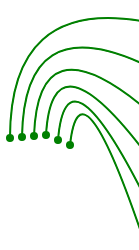In practice, not only in EEG data analysis, often only the well-known PCA (principal component analysis, see https://en.wikipedia.org/wiki/Principal_component_analysis) and for classification in the best case an LDA (linear discriminant analysis, see https://en.wikipedia.org/wiki/Linear_discriminant_analysis) is used together with a support vector machine, see https://en.wikipedia.org/wiki/Support_vector_machine, thus reducing an often non-linear problem to a linear problem.
The non-linearity of the problem is often not adequately addressed by research groups, e.g. they often limit themselves to spectral analyses. However, there is usually much more information to be gained from the data, and this is already the case when using Partial least Square Regression (PLSR) and its further developments instead of linear regression or an LDA-based classification, see https://en.wikipedia.org/wiki/Partial_least_squares_regression.
The same applies to the support vector machine (SVM), which is robust and easy to implement, but has a low classification quality. The use of multivariate methods requires familiarity with them and their mathematical understanding. There are promising further developments of the DCS, which we will discuss here in more detail at the appropriate time.
Advanced extensions of time series analysis include the application of the Hilbert transform, which extends time series analysis to the body of complex numbers, see Freeman.
It is helpful to consider the values of related electrode groups (e.g. Fp1, Fp2, F7, F8) as complex-valued numbers. Especially hyper complex numbers, so-called quaternions, would be suitable here, see https://en.wikipedia.org/wiki/Quaternion. In contrast to normal complex numbers, quaternions have three imaginary parts i, j, k instead of only one. The real part remains as one of 4 components of the hypercomplex number. The advantage is that the 4 components together form a unit and their common behaviour can be determined much easier with the quaternion calculus than it is the case with 4 real-valued EEG values which are considered separately. Their commonalities would then have to be determined first by means of complicated algorithms - for the application of quaternions in EEG analysis, see https://www.mendeley.com/catalogue/0dfb4234-38b0-3b92-9da9-5ac07edc6e18/.


 English
English  Deutsch
Deutsch